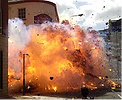Public Safety and Security awareness
The aim of this guide is to help the public manage their own safety and security. It provides the society with skills to be able to assess risk in their daily lives and apply it to keep them-selves safe.
This guide has many common features to many insecure situations, that are helpful in suggesting, prompting, reminding and offering useful tools.


It is based on my training and live experience on a peace keeping mission in Iraq.
Security
Security is the protection of lives and assets from violence and theft.
Security starts with you!
Safety
Safety is the condition of being protected; free from danger, risk, or injury.
Each individual is responsible for safety; the actions of one person can have an effect on the safety of others.
Hazards:
All human activities expose people to hazards. Hazards are activities or “things” with the potential to cause harm. They can be physical, chemical, biological, or even psychological.
Risk:
Risk is the chance that exposure to a hazard will result in harm at some level. It is not possible to eliminate risk, but it is usually possible to reduce it.
Crime watch
Act as “eyes and ears” for the police.
Report suspicious activities and items to police by phone or personally.
Do not worry about being embarrassed if your suspicion proves unfounded. Instead think about what could happen if you do not act.
Information often needed by the police:
-
What happened?
-
When did it happen?
-
Where did it happen?
-
Was anyone hurt?
Description of persons:
When describing suspects, notice age, race, sex, height and weight.
Compare your own weight and height with that of the suspect.
Pick out some unique characteristics of the suspect:
-
scars,
-
nose,
-
jewellery,
-
Clothing, especially shoes etc.
This will help you to identify the suspect in the future if need be.
Description of vehicles:
-
License number,
-
make,
-
model,
-
colour,
-
any noticeable damage and direction of travel.

Skills to assess risk
Things that seem light, "out of place" could develop into a dangerous situation. Be aware!
Monitoring suspicious activities & items
Crowds can be entirely peaceful. However, they can pose risks including theft and
violence. A peaceful crowd can sometimes turn into a violent mob or riot.
It is important to be aware of when crowds are likely to form (such as during festivals or
political demonstrations) and what their purpose is.
If you assess that they may turn violent, keep away.
A peaceful crowd may turn a “dirty game”
Suspicious people can be Suicide bombers, robbers or thieves:
- People that are not where they are supposed to be (restricted area, etc.);
- Look lost or wandering around – especially at the bus stop, parking and maintenance areas;
- Appear to be conducting surveillance (using video cameras, taking photos, etc.);
- Cause disruptions or intentionally distracting behaviour;
- Show an unusual interest in employees or passengers;
- Abandon an item and leave the area quickly;
- Openly possess a weapon and/or prohibited or dangerous item(s); and/or
- Use a vehicle in a suspicious way (illegally parked, erratic driving, following, etc.).
- Do not base suspision on national origin, ethnicity, colour, race, gender, or age but actions.
◄
1/1
►





















